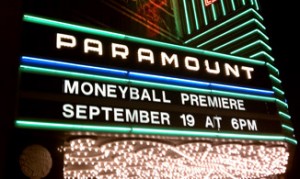Moneyball, the film about Oakland A’s general manager Billy Beane and the team’s historic 20-game winning streak of 2002, was nominated today for six Academy Awards, including Best Picture, Best Actor (Brad Pitt as Beane), and Best Adapted Screenplay (Steven Zaillian and Aaron Sorkin; story by Stan Chervin, from Berkeley author Michael Lewis’s nonfiction book).
Like many die-hard A’s fans, I was an unpaid extra on Moneyball when scenes were shot at the Oakland Coliseum in July and August of 2010. In fact, since I was actually at most of the games that were being re-created, I like to think that I'm a tiny pixel or two in both the background of the 2002 historical footage and in the 2010 recreations.
I turned up for the shoot dressed in the most historically authentic fan gear I owned, including my Scott Hatteberg player T-shirt. I had even removed the “Holy Toledo!” embroidered patch from my Oakland jersey – it commemorates beloved A’s broadcaster Bill King, who died in 2005, but was very much alive in 2002. Excerpts of King’s broadcasts are heard in the film, including his comment on the 20-game winning streak, “Just. Plain. Crazy!”
The filmmakers also went to great lengths to return the 2010 Coliseum to the way it looked in 2002. In this TV news story, crews change the logos on the outfield walls and remove the tarps on the third deck that were added several years after the film takes place. During my night on the set, I was impressed by the scoreboard, which was updated before each shot with out-of-town scores as they actually would have appeared. (We were all made a bit wistful at the sight of MON, the erstwhile Montreal Expos' abbreviation, on the National League side of the board.)
My group of extras was reenacting the scene in Game 20 of the A’s' historic winning streak, in which the actor Stephen Bishop, as outfielder David Justice, chases a flyball into the corner. Because of the layout of the Coliseum, we had to stand up in order to peer into that nook of the field to see if he caught the ball, make appropriately disappointed faces and gestures when he didn’t, and sit down again. After about four takes, the assistant director came over to us and said, “Um, crowd? You don’t need to look that disappointed, your team is still winning.”

